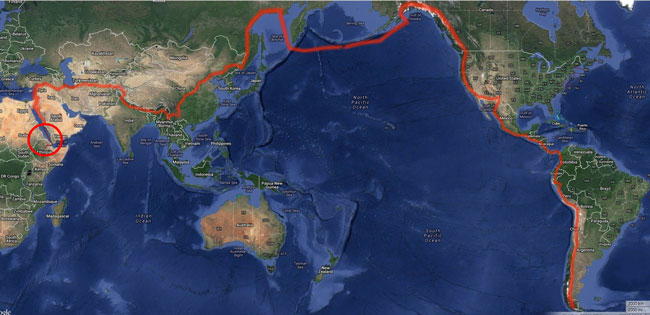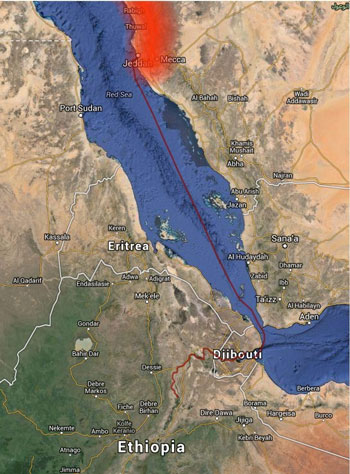
Posted Sept. 6, 2013
I Googled “Saudi Arabia” the other day and got a suspiciously even numbered 461,000,000 results. It will take awhile to sift through all of those links.
At the same time, news reports based on leaks about National Security Agency programs describe the raw collection of “metadata” on American citizens and others, electronically scooping up hundreds of millions of telephone numbers and other communications every day.
This ocean of data both amazes and confounds. (Yes, we want security. No, we don’t want our government spying on us.) In this age of the terabyte and more, we’ve come to think that very little is unknowable if we are searching or if someone else is searching for us. We all just need more data.
Many of us sit at desks in classrooms and offices staring at screens for information. We relate to news and often to each other in electronic bytes, share photos and interact with the rest of the world in ways our parents, much less our ancestors, never imagined. We sit in a rarely changing environment, we have “Google” perceptions of life outside our range and much of what we write and talk about is second-hand at best.
Those mammoth amounts of raw information are in stark contrast to a journalistic project so traditional and counterintuitive that it stirs both excitement and wistful thoughts in most who hear of it.
Paul Salopek’s “Out of Eden Walk” is immersive in every sense. He is relying on his senses, and his own physical endurance, to report what it is like now to walk through the world, or at least a good part of it.
Salopek, a two-time Pulitzer Prize winner, is already more than 1,000 miles into a planned 21,000-mile trek tracing the prehistoric migration of humans from the “Eden” of the Great Rift Valley in Ethiopia up to the Middle East, which will be his bridge to central Asia. (See where Salopek was as of Sept. 5).
Through China and then Siberia, he intends to cross the Bering Strait (by boat) and continue walking down along the western edge of the North and South American continents, ending in that most romantic of ending places, Tierra del Fuego.
“I am a discursive walker. I zigzag. I stop. I veer. I scribble with my feet,” Salopek wrote on his website as he set off on this most excellent adventure. “Why am I doing this. . . . For the usual knot of reasons. To transport my brain into the Pleistocene. (The mind-frame of the primordial African hunters whose footsteps I am retracing.)
“To tell stories. To see, to listen, to think, etc. But also, it must be conceded, because of peccadillos: odd notions absorbed from 19th-century Transcendentalists (Thoreau: “We should go forth on the shortest walk, perchance, in the spirit of undying adventure, never to return; prepared to send back our embalmed hearts only, as relics to our desolate kingdoms.”)”

Salopek’s planned route. The red circle in the Mideast shows the trek he’s completed so far. See closeup below, right.
Salopek, who once spent the better part of a year walking the Sierra Madre, has an almost monastic approach to journalism. He dismisses most of the comforts of travel because he believes they interfere with getting to the actual stories. He embraces modern technology and social media in every form if it brings the story home.
But he isn’t in thrall to technology and dismisses unnecessary bells and whistles; once when I was his editor he was driving up the Hindu Kush in northern Afghanistan to meet up with the Northern Alliance as it prepared to battle the Taliban. He threatened to throw his new, fancy but malfunctioning computer under the tracks of a passing tank. He wanted his old trusty computer back, the one that survived desert and jungle trips. Perhaps it was a sign that he finished his trip on horseback.
For those who imagine what it would be like to traverse continents on foot, here is how Salopek described part of his walk near Jeddah, along the western edge of Saudi Arabia:
“Days of molten chrome, nights of damp black velvet.
“We walk north through the desert near the Red Sea coast. We drip asterisks of sweat into the sand. We take shade in the scalding afternoons beneath highway overpasses that moan with traffic. We cross other shores.”
Retracing on foot the path our ancient ancestors traveled as they migrated across the world.
Another friend, Evan Osnos, who writes for the New Yorker, once asked Salopek for advice when Osnos was planning a trek through China’s Sichuan Province.
In his New Yorker blog, Osnos wrote that Salopek took the question seriously and replied: “If you’re going to take a mule, give yourself enough time to learn how to handle it. It’s more difficult than flying a plane.” Osnos noted Salopek was speaking from experience; a mule had broken his nose.
Osnos repeated his favorite tweet from Salopek when he was in Ethiopia:
No wells. Bummed murky water off nomads in this enormity. Electric blue moonlight the color of pure thought. #edenwalk
— Paul Salopek (@PaulSalopek) January 26, 2013
While he uses the best electronic equipment to send back reports, plots his progress on a digital map feature, take photos and video, Salopek is gathering stories, meeting and interviewing people, and taking the measure of life at a very human pace.
National Geographic is sponsoring the first two years of the walk, and there are two educational partners, the Pulitzer Center on Crisis Reporting and Project Zero at Harvard, that are creating learning programs around the walk. Salopek is not only a personal friend, but I am also on the board of advisers for his journey.
“Yet the experience of pacing off the continents, one yard at a time through 2020, will still expose, I believe, an inescapable biological reality. We’re built to walk. We’ve been wired by natural selection to absorb meaning from our days at the loose-limbed gait of three miles an hour. . . . To watch. To listen. To glance over our shoulders, seeking older compass bearings. Those first bands of Homo sapiens who blazed the trail to our becoming a planetary species—hunter-gatherers we know oddly little about and who may have numbered, researchers say, a paltry few thousand individuals—have valuable lessons to impart. They were, after all, consummate survivors.”
There’s nothing better than listening to Salopek himself describe the journey in his own cadence, as he did in a recent interview with National Public Radio. Listen below.
As a journalist, he avoids chatter and focuses on the experience. While most of us sit in controlled environments, he doesn’t look up weather reports but feels the warmth of the sun on his back. He is walking through the world and doing his own reporting, making little clouds of dust all along the way.
Tim McNulty is co-director of the Medill National Security Journalism Imitative and a lecturer at Northwestern University’s Medill School. He was a longtime foreign correspondent and senior editor at the Chicago Tribune. He helped direct the newspaper’s coverage of the September 11 tragedy, the American strike into Afghanistan and the invasion of Iraq.







